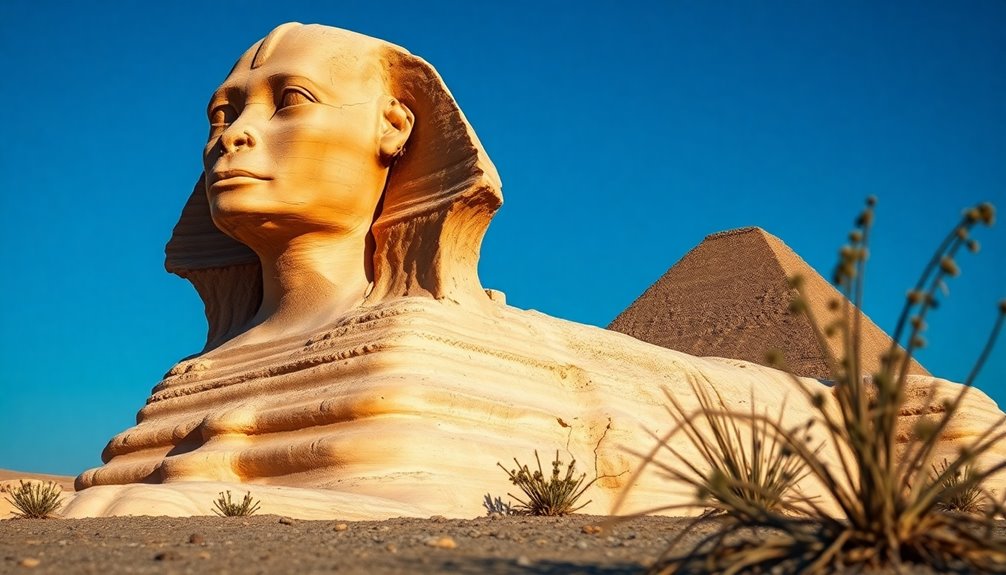The Sphinx shows evidence of significant water erosion that challenges the traditional timeline of its construction. Researchers suggest this erosion indicates heavy rainfall and flooding, possibly dating back to before 2500 BC, during a much wetter climate. This contradicts previous beliefs that it was built during a dry period. Scholars like Robert Schoch advocate for this water erosion hypothesis, raising intriguing questions about ancient civilization timelines. Understanding these geological factors changes how we view the Sphinx and its history. There's much more to explore about these findings and their implications for ancient Egypt's environmental story.
Key Takeaways
- Geological evidence suggests heavy rainfall and flooding shaped the Sphinx, contradicting traditional beliefs about its construction during a drier climate around 2500 BC.
- Water erosion patterns on the Sphinx indicate significant weathering linked to climate changes, potentially dating its origins to around 5300 BC.
- Robert Schoch's water erosion hypothesis argues for an earlier construction date, challenging the notion that the Sphinx was built solely during Pharaoh Khafre's reign.
- Critics highlight the lack of advanced civilization evidence before Khafre, questioning Schoch's methodology and the implications of his findings on archaeological interpretations.
- Ongoing collaborative research between geologists and Egyptologists aims to redefine timelines and enhance understanding of the Sphinx's historical significance amid changing climates.
Overview of the Sphinx

The Sphinx's impressive presence has captivated visitors for centuries. Carved from a single limestone ridge, it measures about 240 feet long and 66 feet high, making it one of the largest monolithic sculptures in the world. Believed to have been constructed during the reign of Pharaoh Khafre around 2500 BC, the Sphinx is part of a complex that includes the Pyramid of Khafre and the Valley Temple.
However, geological evidence raises intriguing questions about its age. Studies show that the erosion patterns on the Sphinx mightn't align with traditional dating methods. Some researchers, like Robert Schoch, argue that the water erosion visible on the Sphinx suggests it may have been carved long before the Egyptian civilization, possibly around 9700 BC, during a time of significant rainfall.
Additionally, the Sphinx Temple, built from blocks carved around the Sphinx's body, remains unfinished, hinting at construction challenges and possible shifts in the project's original plans.
This blend of majestic structure and geological mystery makes the Sphinx a subject of ongoing fascination and debate among historians and archaeologists alike.
Historical Context and Theories
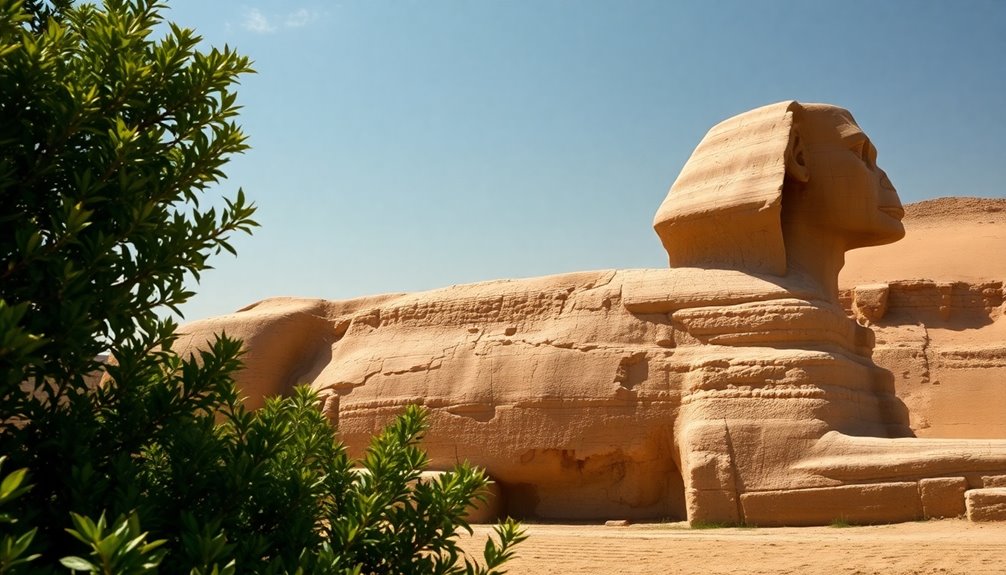
When you explore the historical context of the Sphinx, you'll find theories that link its erosion patterns to ancient myths like Atlantis.
This connection raises questions about the timeline of its construction and the climate conditions of that era.
As you consider the controversies surrounding erosion dating, it's crucial to weigh both the intriguing possibilities and the skepticism from mainstream archaeology.
Atlantis Myth Influence
While many scholars attribute the construction of the Sphinx to Pharaoh Khafre during the Fourth Dynasty, the erosion patterns observed on the monument have sparked a fascinating debate influenced by the Atlantis myth.
Researchers like John Anthony West and Robert Schoch argue that significant rainfall in ancient times could indicate the Sphinx was built much earlier than previously thought. This aligns with Edgar Cayce's readings, which suggest a timeline for Atlantis's destruction around 10,500 BC.
The implications of the Atlantis myth on the Sphinx are profound, posing questions about earlier civilizations and their capabilities.
Consider these points:
- Evidence suggests the Sphinx's erosion patterns could result from Nile floods between 15,000 and 10,000 BC.
- The timeline proposed by Schoch implies the Sphinx may predate accepted dynastic periods.
- Alternative theorists argue for the existence of a lost civilization capable of monumental construction.
- The debate challenges mainstream archaeology, pushing for a reevaluation of historical narratives.
This intersection of myth and evidence fuels ongoing discussions about humanity's ancient past and the potential for civilizations long forgotten.
Erosion Dating Controversies
Erosion patterns on the Sphinx raise significant questions about its age and the techniques used in its construction. John Anthony West and Robert Schoch argue that the Sphinx's water erosion indicates it was carved long before the mainstream Egyptology timeline, suggesting a date as far back as 9700 BC, just after the last ice age. This theory challenges traditional erosion dating methods, which typically align the Sphinx with Pharaoh Khafre's 4th dynasty.
Geological evidence shows significant rainfall and flooding may have affected the Sphinx, contradicting beliefs that it was constructed during a drier period. While luminescence dating supports Khafre's reign, the erosion patterns hint at an older origin, igniting fierce debates among researchers.
Critics like Mark Lehner dismiss the idea of an advanced ancient Egyptian civilization existing before Khafre, questioning the validity of alternative dating theories.
This discourse reveals a complex interplay of geological and archaeological interpretations, as conflicting evidence continues to fuel discussions regarding the Sphinx's timeline and the environmental factors influencing its formation.
Ultimately, understanding the Sphinx's true age remains a contentious issue in the study of ancient civilizations.
Geological and Archaeological Evidence
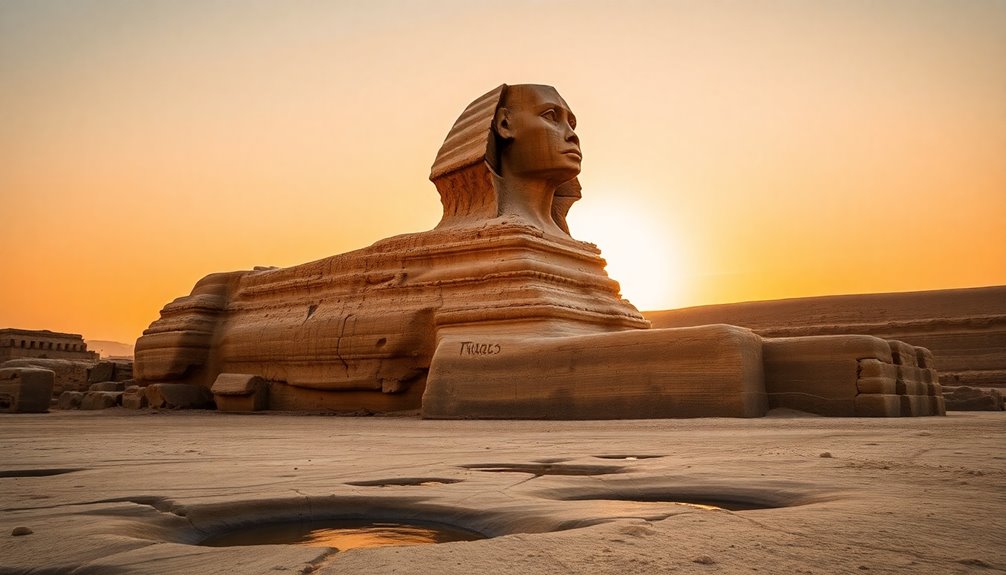
How does the geological evidence surrounding the Sphinx challenge our understanding of its origins? The Sphinx might be much older than we once believed. Geological evidence suggests that the erosion patterns observed indicate considerable weathering consistent with water processes. This contradicts the traditional dating of its construction around 2500 BC. Research by Robert Schoch supports this notion, proposing that these erosion patterns could point to origins dating back to 9700 BC or earlier.
Key findings include:
- Erosion patterns may have started before the Sphinx was even carved.
- Luminescence dating techniques indicate construction aligns with the 4th dynasty, yet geological data shows inconsistencies.
- Gradual climate change in the Sahara around 5300 BC likely contributed to severe weathering.
- The complex history of environmental impact suggests a more nuanced understanding of the Sphinx's timeline.
This evidence suggests that we need to rethink our historical narratives about the Sphinx. The implications of this research could considerably alter our perceptions of ancient civilizations and their relationship with the environment.
Erosion Mechanisms Explained
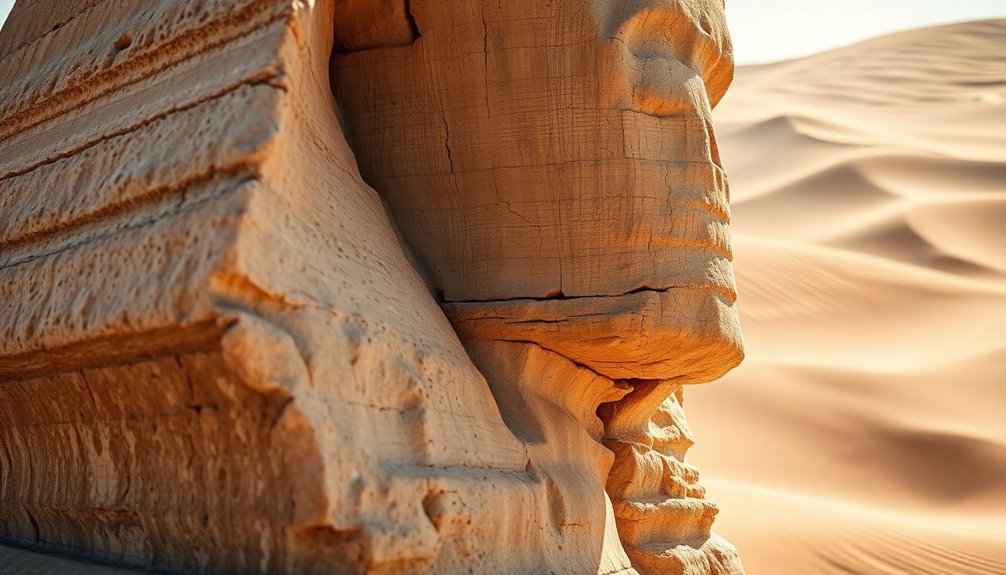
When you examine the Sphinx, you'll notice the effects of natural water processes that have shaped its surface over millennia.
Geological evidence suggests that significant weathering occurred long before the monument was carved, challenging traditional timelines.
Understanding these erosion mechanisms is essential for grasping the Sphinx's history and its enduring vulnerability.
Natural Water Processes
Natural water processes play a crucial role in shaping the landscape, and their effects on ancient monuments like the Sphinx are particularly telling. Erosion patterns on the Sphinx reveal a history of heavy rainfall and flooding that contributed to its weathering. Jørn Christiansen's findings suggest that some erosion took place before the Sphinx was even carved, indicating the relentless power of natural elements.
Consider these key points:
- Erosion on the Sphinx resulted from prolonged exposure to water.
- The quality of Giza limestone has made the Sphinx more vulnerable to weathering.
- Gradual climate change has shifted the region from wet to arid conditions.
- Significant climatic events at the end of the last ice age may influence the Sphinx's age.
These factors illustrate how natural water processes not only shape landscapes but also impact human creations over time.
The Sphinx stands as a symbol of the power of nature, reminding us that even the most monumental structures aren't immune to the relentless forces of erosion that define our world. Understanding these processes deepens our appreciation for the Sphinx's historical context and the environmental challenges it has faced.
Geological Evidence Analysis
Geological evidence reveals that the Sphinx's erosion results primarily from water exposure rather than just wind and sand. Research indicates that the erosion patterns you observe have been greatly influenced by prolonged rainfall rather than solely by common desert elements.
Jørn Christiansen's findings suggest that some of the Sphinx's erosion occurred before its carving, hinting at existing geological factors on the Giza Plateau that contributed to its deterioration.
The quality of Giza limestone, as highlighted by archaeologist Zahi Hawass, plays an essential role in the Sphinx's erosion. This limestone is particularly susceptible to weathering, which accelerates the degradation process.
Additionally, Robert Schoch's water erosion hypothesis proposes that the observable patterns suggest the Sphinx is much older than previously thought, potentially dating back to the end of the last ice age.
Lastly, studies by Kuper and Kröpelin connect the Sphinx's erosion to historical climate shifts in the Sahara. These gradual changes led to considerable weathering effects, reinforcing the idea that the monument's erosion is deeply intertwined with environmental conditions over time.
Understanding these geological factors reshapes our perspective on the Sphinx's history and significance.
Climate Change Impact
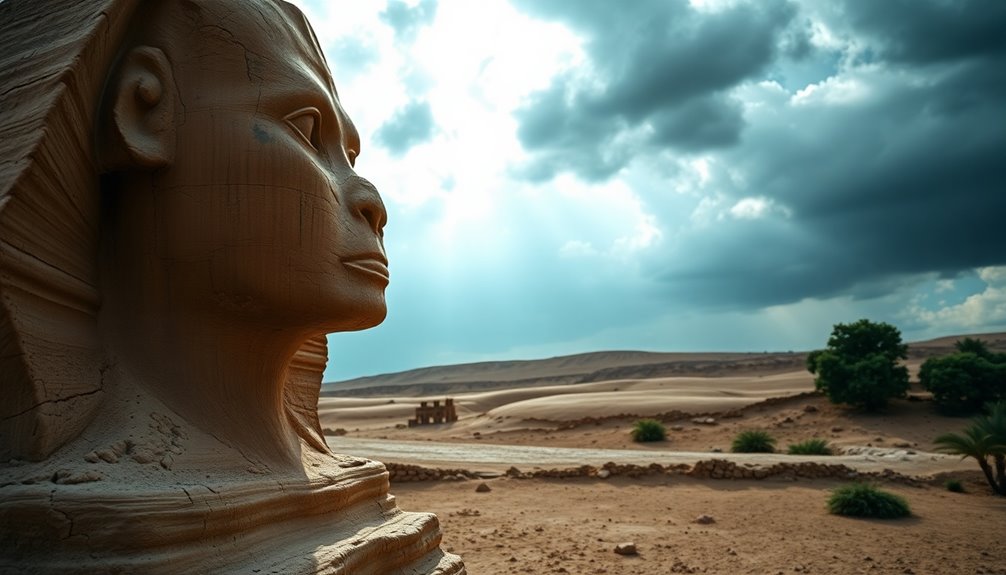
Climate change has played an essential role in the erosion of the Sphinx, as evidenced by various studies. Researchers like Kuper and Kröpelin indicate that the gradual climate change in the Sahara led to arid conditions by 5300 BC. This shift likely contributed to the weathering patterns observed on the Sphinx.
Mark Lehner's work correlates severe weathering on the Sphinx with climate fluctuations, suggesting these changes notably impacted erosion processes. Judith Bunbury's sediment analysis further supports the notion of early Old Kingdom climate change, revealing environmental shifts that affected the Sphinx's preservation.
- The Sphinx has faced erosion due to changing precipitation patterns.
- Fluctuations in climate may have accelerated the weathering processes.
- Evidence suggests substantial rainfall and flooding impacted the Sphinx's structure.
- Geological findings indicate the Sphinx's origins may predate traditional timelines.
Understanding how climate change has influenced the Sphinx's erosion helps us appreciate the monument's complex history. By recognizing these environmental factors, we can better grasp the challenges facing ancient structures and the need for preservation efforts in a changing climate.
Criticism and Controversies
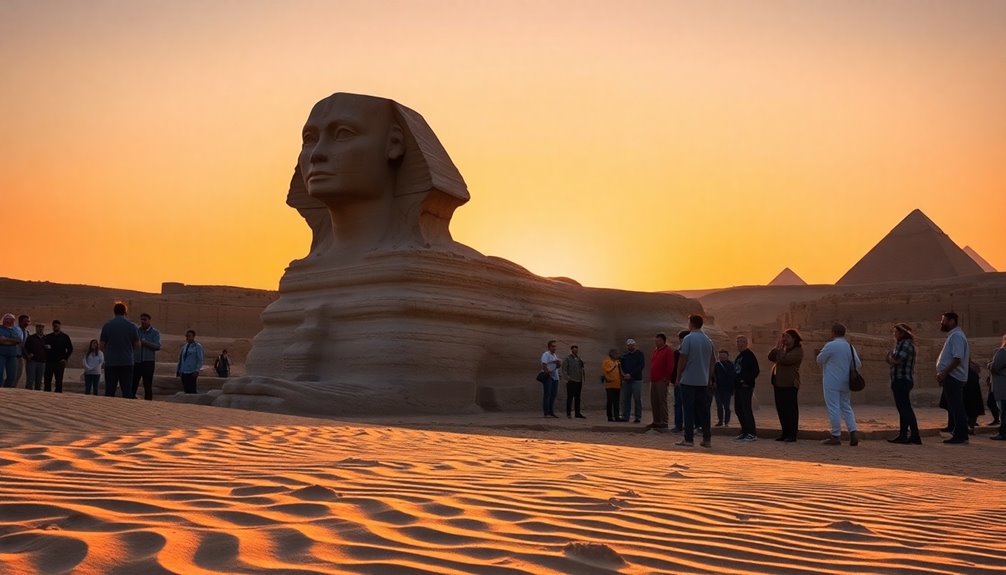
The ongoing discussions about the Sphinx's erosion have sparked significant criticism and controversies, particularly surrounding Robert Schoch's water erosion hypothesis. Critics argue that his methodologies lack rigor.
For instance, Mark Lehner suggests that the Sphinx cult wasn't established, pointing to the scarcity of cultural artifacts from its supposed earlier period. Kenneth Feder further questions the feasibility of Schoch's claims, highlighting the absence of infrastructural evidence for a civilization capable of constructing the Sphinx before the 4th Dynasty.
This ongoing debate between traditional Egyptology and alternative theories often leads to skepticism among mainstream archaeologists about Schoch's conclusions. Conflicting interpretations of geological evidence regarding the Sphinx's erosion patterns add to the controversies, complicating the timeline and purpose of this monumental structure.
Moreover, the role of ideology in archaeological interpretation remains contentious. Established scholars frequently dismiss alternative theories as preposterous, which hinders the acceptance of new ideas within the field.
As you explore the complexities of the Sphinx's history, you'll find that understanding these criticisms is essential for grasping the broader discussions surrounding its origins and significance.
Key Figures and Ongoing Research
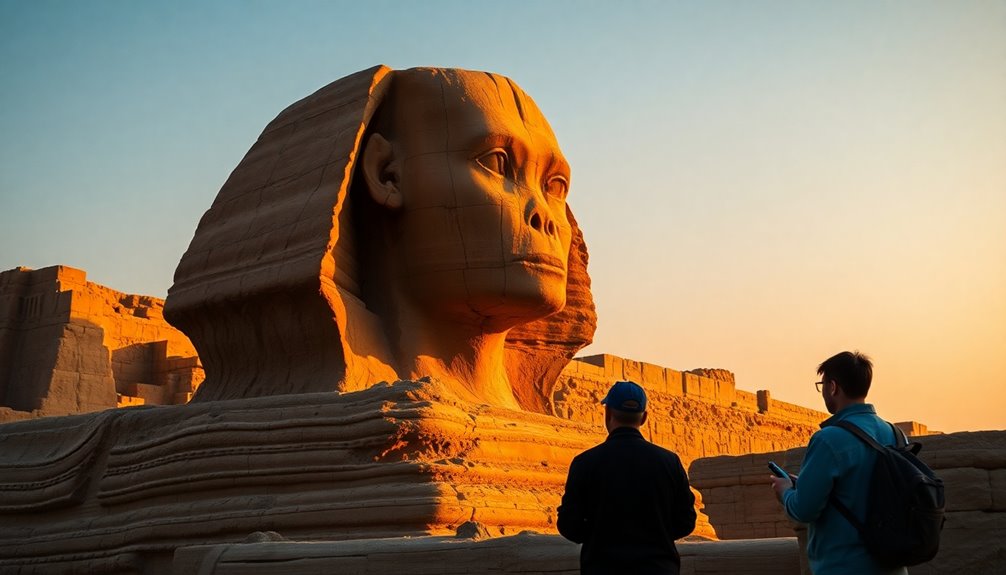
Exploring the key figures in the study of the Sphinx reveals a dynamic interplay of ideas and ongoing research that shapes our understanding of this iconic monument.
Prominent voices like Robert Schoch advocate for the water erosion hypothesis, arguing that the weathering patterns of the Sphinx suggest an age that predates traditional dating methods. In contrast, Mark Lehner emphasizes the archaeological context, aligning the Sphinx with Pharaoh Khafre's reign and its intended purpose.
Zahi Hawass plays a vital role in restoration efforts while challenging alternative theories regarding the Sphinx's age and construction. Ongoing research is essential in this debate, as scientists employ geological studies to investigate the implications of erosion patterns, which could reshape perceptions of the Sphinx's history.
- Collaborative efforts between geologists and Egyptologists are enhancing our understanding.
- Climate-controlled studies in the Sahara link environmental factors to civilization development.
- The Giza Plateau continues to be a focal point for archaeological discoveries.
- New findings may redefine our timeline of the Sphinx's construction and significance.
Frequently Asked Questions
Is the Water Erosion on the Sphinx Debunked?
You might find that the debate over water erosion on the Sphinx isn't definitively debunked.
While critics argue against the water erosion hypothesis due to a lack of supporting artifacts, some geological studies suggest the erosion patterns align more with rainfall than wind.
This ongoing discussion reflects a divide in the archaeological community, leaving room for alternative theories.
What Is the New Theory of the Sphinx?
Have you ever wondered why the Sphinx shows signs of water erosion?
The new theory, primarily from geologist Robert Schoch, suggests the Sphinx is much older than previously thought. He argues that the erosion patterns indicate significant rainfall and flooding, dating back to before 5000 BC.
This implies it was carved during a wetter climate, linking its age to prehistoric events and challenging the traditional timeline established by Egyptologists.
Do the Pyramids Show Signs of Water Erosion?
When you examine the pyramids, you'll notice some signs that might suggest water erosion.
Geological studies show that the limestone used is vulnerable to erosion, and patterns of weathering could align with historical periods of increased rainfall.
However, a lack of contemporary inscriptions about water-related events complicates the picture.
Is the Sphinx 26000 Years Old?
You might wonder if the Sphinx is 26,000 years old.
While some researchers argue for a much older date, suggesting it could be over 10,000 years older than traditionally thought, definitive evidence for a 26,000-year timeline isn't widely accepted.
Geological studies indicate significant weathering consistent with water erosion, hinting at an earlier construction period.
However, the lack of contemporary records keeps the true age shrouded in mystery and debate among scholars.
Conclusion
Ultimately, the Sphinx's water erosion challenges what we've long believed about ancient civilizations and their landscapes. As new evidence emerges, like the findings from the Giza Plateau excavations showing signs of heavy rainfall, it's clear we need to rethink our understanding of history. Imagine if future discoveries reveal a lost civilization thriving in a lush, water-rich environment—this could reshape our entire perspective on how humans adapted to their surroundings. The mystery of the Sphinx is just beginning.

